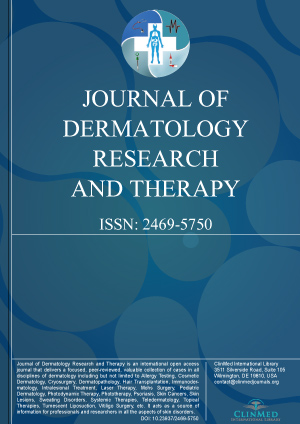Open Access DOI:10.23937/2469-5750/1510024
Dry Eye Syndrome: What the Dermatologist Needs to Know
David M. Kleinman
Article Type: Short Review | First Published: April 21, 2016
It is very likely that dermatologists will see patients who have both skin concerns and concomitant dry eye syndrome. Over 25 million Americans have some form of dry eye, and symptoms related to dry eye are one of the leading causes of visits to ophthalmologists. Dry eye syndrome can often be easy to diagnose, and the first line of interventions are simple, low risk, and low cost. Specialists and subspecialists are generally averse to making medical recommendations outside their field of experti...
Open Access DOI:10.23937/2469-5750/1510023
Anti-Androgen Therapy in Female Adult Acne
Jing Gao and Anjali Mahto
Article Type: Review Article | First Published: April 20, 2016
Acne vulgaris is a multifactorial disease of the pilosebaceous unit as a result of androgen-induced increased sebum production, altered keratinisation, inflammation, and hair follicle bacterial colonisation by Propionibacterium acnes (P. acnes). The clinical features of acne include seborrhea, comedones, and papules and pustules. Nodules and cysts are seen in severe nodulocystic acne and scarring can follow. Acne can occur alone or with signs of hyperandrogenism such as hirsutism, alopecia and m...
Open Access DOI:10.23937/2469-5750/1510022
Folliculotropic Mycosis Fungoides: A Clinicopathological Study of a Series of 10 Cases
V Vergote, P Wolter, E Hauben and AM Busschots
Article Type: Case Report | First Published: April 13, 2016
Ten patients (8 male, 2 female) with a median age at diagnosis of 45 years were included. The median duration of the presence of skin lesions before diagnosis was 11 years. The most common sites of involvement were head and neck (80%), trunk and extremities (80-90%). Clinical features included patches and plaques, often associated with follicular prominence and alopecia, or comedo-like lesions, nodules and cysts. Fifty percent complained of pruritus. Histological findings included folliculotropi...
Open Access DOI:10.23937/2469-5750/1510021
Facial Follicular Mucinosis in Adolescence
Gokce Isil Kurmus, Filiz Canpolat, Muzeyyen Gonul and Murat Alper
Article Type: Case Report | First Published: April 12, 2016
Follicular mucinosis (FM), also known as alopecia mucinosa, is a rare inflammatory disorder that characteristically presents as follicular papules or infiltrated plaques with prominent follicular openings associated with alopecia. Histologically, the disorder is characterized by mucin deposition in the follicular epithelium and sebaceous glands. FM was classified in two distinct entities: a primary or idiopathic form, usually presents in children and young adults with a benign course, and a seco...
Open Access DOI:10.23937/2469-5750/1510020
New Insights and Therapeutic Implications in Cutaneous Melanoma
Pinar Ozuguz, Seval Dogruk Kaca and Serap Polat
Article Type: Review Article | First Published: April 11, 2016
Melanoma is a highly aggressive tumour with poor prognosis in the metastatic stage that arises and evolves due to a myriad of genetic and epigenetic events. Among these, the interaction between epigenetic alterations (i.e., DNA methylation, histone modifications, mRNA silencing by miRNAs and nucleosome repositioning) has been recently identified as playing an important role in melanoma development and progression by affecting key cellular pathways such as cell cycle regulation, DNA repair, apopt...
Open Access DOI:10.23937/2469-5750/1510019
Targeted Prodrug Design for the Treatment of Malignant Melanoma
Marcella Gabrielle Mendes Machado, Paulo Renato Yamasaki, Jean Leandro dos Santos and Chung Man Chin
Article Type: Short Review | First Published: April 04, 2016
Malignant melanoma is a serious health problem once the current chemotherapy exhibits resistance to traditional drugs. Several challenges must be overcome during drug design in order to increase the efficacy and safety of the new drugs. Therefore, the specific chemical release of cytotoxic agents near to the target is an attractive approach to improve the anticancer activity and reduce the systemic toxicity. Herein, this review article describes the advances in the development of targeted prodru...
Open Access DOI:10.23937/2469-5750/1510018
Pyoderma Gangrenosum: A Review of Orthopedic Case Reports
Stephanie Chapman, Daniel Delgadillo and David T. Rispler
Article Type: Short Review | First Published: March 09, 2016
Pyoderma gangrenosum (PG) is an uncommon disease characterized by necrotic ulcers that are often associated with underlying systemic disease. PG can occur at the surgical site following surgery, including orthopedic surgery, and may be commonly mistaken for postoperative infection, delaying diagnosis and resulting in wound deterioration and subsequent sequelae. Previously, 20 case reports of PG have been reported after orthopedic surgery. We reviewed these cases and found the majority (60%) were...

